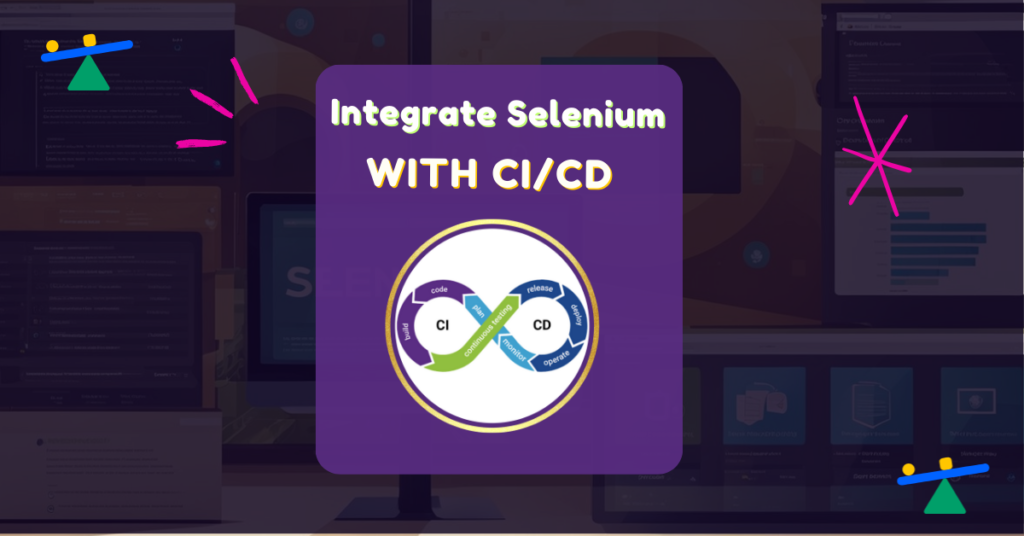
Selenium Integration with CI/CD is essential for modern software development. This integration allows teams to automate their testing processes while ensuring high quality in their applications. By combining Selenium with Continuous Integration and Continuous Deployment practices, developers can detect and fix bugs earlier in the development cycle, greatly enhancing the overall quality assurance process.
As software development evolves, the demand for efficient testing methods has grown. Automation testing, particularly with tools like Selenium, streamlines the workflow and significantly reduces manual effort. This shift not only increases productivity but also elevates career growth opportunities for those skilled in automation, as businesses increasingly prioritize rapid delivery and real-time feedback.
Implementing Selenium in CI/CD pipelines enables teams to run tests automatically each time code is updated. This not only minimizes the risk of defects but also accelerates the release cycle. To understand the importance of software testing in this context, it is crucial to recognize its role in identifying bugs and ensuring functionality before release.
Understanding CI/CD and Selenium
In modern software development, integrating testing with CI/CD pipelines is essential. This section covers the basics of Continuous Integration and Continuous Deployment, the use of Selenium for automated testing, and the importance of browser testing in CI/CD.
Basics of Continuous Integration and Continuous Deployment
Continuous Integration (CI) is the practice of automatically testing code changes. When developers submit their code, it triggers automated tests. This helps find bugs early. In contrast, Continuous Deployment (CD) ensures that every successful code change gets automatically deployed to production.
Together, CI and CD streamline the release process. They promote a feedback loop that enhances code quality. With rapid and reliable releases, developers can focus more on features rather than debugging.
Introduction to Selenium for Automated Testing
Selenium is a powerful tool for automating web browsers. It allows developers to write tests in various programming languages like Java, C#, and Python. Automated testing with Selenium helps ensure the application’s behavior is consistent across different browsers.
Developers can run tests for user interactions, such as clicking buttons or filling out forms. This capability makes Selenium an integral part of automated testing strategies. It enables teams to quickly verify that new features work as intended after each code change. For those just starting, detailed resources to learn Selenium offer practical tips for effective web automation.
The Role of Automated Browser Testing in CI/CD
Automated browser testing is vital for CI/CD pipelines. It allows continuous validation of web applications’ functionality after each update. This testing can include various scenarios to mimic user actions.
With these tests, teams can catch issues before they affect users. Selenium fits perfectly into this workflow. By integrating it into CI/CD pipelines, teams can ensure that their web applications are reliable and maintain high quality. Automated tests can save time and reduce the manual effort involved, leading to faster development cycles.
Effective implementation of CI/CD with Selenium enhances the overall development process, allowing teams to deliver high-quality software more efficiently.
Setting Up a Selenium CI/CD Pipeline
Creating a Selenium CI/CD pipeline is essential for ensuring that automated tests run consistently throughout the development cycle. This process involves integrating testing tools, configuring pipelines, and utilizing version control systems effectively.
Integrating Selenium with CI/CD Tools
Integrating Selenium with CI/CD tools is a critical step in establishing an effective testing pipeline. Popular CI/CD platforms like GitHub Actions and GitLab CI offer built-in support for Selenium. By using these platforms, teams can automate test execution whenever code is pushed to the repository.
To begin, choose a CI tool that best fits the project’s needs. From there, write and configure test scripts in Selenium. These scripts can be triggered by the CI/CD pipeline during various stages, such as during code commits or merges. This approach helps catch bugs early and improves the overall quality of the software.
Configuring a CI/CD Pipeline for Selenium
To configure a CI/CD pipeline for Selenium, creating a clear structure is key. Initially, developers should establish a .gitlab-ci.yml file or an equivalent configuration for their chosen CI tool. This file determines how the pipeline runs.
Within the CI configuration, specify the environment where tests will be executed. It’s essential to set up any required dependencies, such as browsers and Selenium WebDriver. For instance, if using GitLab, the basic structure might include stages for installation, testing, and deployment.
It’s also crucial to define how test results are reported. Proper reporting allows developers to quickly identify failures and take corrective actions. Clear logs and insights from test runs can significantly enhance productivity.
Harnessing GitHub and .gitlab-ci.yml
Using GitHub Actions or GitLab CI provides a seamless way to manage Selenium tests. The .gitlab-ci.yml file details each job in the pipeline. It includes stages like build, test, and deploy. Each of these stages can have specific jobs that run various Selenium tests.
For instance, a basic job could look like this:
test:
stage: test
image: selenium/standalone-chrome
script:
- npm install
- npm test
This example shows how to use a Selenium Docker image, which simplifies environment setup. Using containers ensures consistency across different test runs. This approach also improves efficiency, making it an excellent choice for teams looking to enhance their Selenium CI/CD workflow.
Tools and Technologies for Seamless Integration
Integrating Selenium with CI/CD pipelines involves using specific tools and technologies. This ensures efficient testing, better performance, and enhanced scalability while making the process smoother.
Leveraging Jenkins for Continuous Integration
Jenkins is a widely used CI/CD tool that automates the software development process. It allows for continuous integration, where developers can frequently commit code changes.
With Jenkins, teams can set up a pipeline that automatically builds and tests applications every time changes are made. This reduces manual efforts and helps in catching issues early.
Jenkins supports various plugins for Selenium, making it easy to integrate test scripts. This enables teams to run tests in parallel, thus increasing test coverage and speeding up the feedback loop.
Utilizing Online Selenium Grids
Online Selenium Grids provide a powerful platform for running tests across multiple environments and browsers. These grids enable parallel execution of test cases, making them ideal for enhancing performance and scalability.
Platforms like LambdaTest allow testers to run automated tests in the cloud. This eliminates the need for maintaining physical infrastructure and offers flexibility in test execution.
Using an online grid means tests can be run on different browser versions and systems concurrently. This leads to faster testing cycles and more reliable results, as cross-browser compatibility can be easily verified.
CI/CD Tools Compatibility
Many CI/CD tools support integration with Selenium to streamline workflows. Tools like GitHub Actions and CircleCI provide seamless integration, allowing for rapid deployment and testing.
These tools helps teams maintain code quality while automating build and deployment processes. They simplify the integration of Selenium tests into the CI/CD pipeline, ensuring consistent testing practices.
Moreover, with the rise of cloud solutions, compatibility with various CI/CD tools has improved. This flexibility helps teams select tools that best fit their workflows, thereby maintaining optimal performance across the development cycle.
Developing and Maintaining Test Code
Effective management of test code is crucial in maintaining high-quality Selenium tests. This section covers writing maintainable tests, managing dependencies, and debugging strategies essential for robust automation.
Writing Maintainable Selenium Tests
Writing maintainable Selenium tests involves creating clear, understandable, and reusable code. Testers should organize tests into logically grouped classes and use descriptive naming conventions for methods. This makes it easier for others to understand the purpose and flow of the tests.
Incorporating comments is important for complex sections. They can explain the reasoning behind certain decisions or specific test outcomes. Utilizing design patterns, such as the Page Object Model (POM), can also improve maintainability. POM helps separate test logic from the page structure, making updates easier as the web application changes. Resources like the Selenium Cheat Sheet provide quick references for best practices.
Managing Dependencies and Version Control
Managing dependencies and version control is key to maintaining test stability. Test projects often rely on several libraries and frameworks. It’s essential to keep these updated to avoid conflicts or deprecated functions.
Using a dependency management tool, such as Maven or Gradle, can help streamline package management. These tools automatically manage version updates and can resolve compatibility issues.
Version control systems like Git should be used to track changes in the test code. Frequent commits allow for easier rollback if new tests introduce failures. Ensuring that the test code adheres to a consistent structure promotes better collaboration among team members, thus enhancing the efficiency of Selenium test automation.
Debugging Tests in Selenium
Debugging is an inevitable part of maintaining Selenium tests. When tests fail, it’s important to isolate the issue quickly. A good practice is to use log files that capture the execution flow, which helps identify where the failure occurs.
Selenium also provides various tools, such as screen captures and step-by-step execution. These features can clarify why a test failed. Learning to use the tools effectively reduces downtime and improves confidence in test reliability.
Testers should ensure they have robust error-handling mechanisms in place. Handling exceptions gracefully can prevent tests from failing silently. Regularly debugging tests increases their reliability, contributing to more efficient Selenium test automation.
Enhancing Test Capabilities
Selenium integration with CI/CD can significantly improve testing performance by introducing advanced capabilities. Focused approaches such as cross-browser testing, headless browser usage, and test scaling enhance overall testing effectiveness.
Implementing Cross-Browser Testing
Cross-browser testing is essential for ensuring that web applications function correctly on various browsers. Selenium allows users to automate tests across different environments, ensuring consistent performance.
To implement this, testers can create a robust test suite that includes scripts for multiple browsers like Chrome, Firefox, and Safari. Tools like Selenium Grid facilitate distributed testing, allowing tests to run parallelly across different setups. This not only saves time but also ensures comprehensive test coverage, identifying potential issues that may arise in specific browsers.
Leveraging Headless Browsers for Performance
Headless browsers are browser instances that run without a graphical user interface. They are ideal for automated testing scenarios because they consume less memory and execute tests faster.
Using headless browsers like Chrome Headless or PhantomJS can drastically reduce test execution time. This is particularly useful in Continuous Integration (CI) environments where quick feedback is critical. They enable teams to validate performance without the overhead of rendering a UI, leading to efficient resource utilization.
Scaling Selenium Tests
Scaling Selenium tests is crucial when handling larger applications or more complex test scenarios. As testing requirements grow, employing strategies like parallel execution becomes necessary.
Using Selenium Grid allows multiple tests to be executed simultaneously on different machines and browsers. This enhances scalability, accommodating a growing number of test cases without compromising quality. Additionally, integrating cloud-based testing services can enable teams to scale their testing infrastructure as needed, ensuring consistent test performance.
Continuous Testing and Quality Assurance
Continuous testing is essential for maintaining high software quality throughout the development and deployment cycles. By integrating tools like Selenium into the testing process, teams can catch defects early and respond quickly to changes. This enhances the overall efficiency of development and ensures that new features meet quality standards before deployment.
Best Practices for Continuous Testing with Selenium
Implementing best practices in continuous testing helps streamline the process. Teams should use Test Automation Frameworks to organize test cases and improve maintainability. Utilizing Selenium Grid allows for parallel execution of tests on multiple browsers, which saves time. Additionally, utilizing Version Control Systems ensures that test scripts are kept up to date and can be easily accessed.
Regularly reviewing test cases helps to remove unnecessary or outdated tests, improving overall efficiency. Establishing a clear test strategy based on project goals is critical. Incorporating Visual Regression Testing improves quality by checking that UI changes do not adversely affect user experience. For deeper insights, teams can explore solutions for effective visual regression testing in CI/CD.
Metrics and Quality Assurance in CI/CD
To measure quality assurance effectively, teams need to track vital metrics. Test Coverage indicates how much of the code is tested, guiding improvements in test cases. Teams may also monitor Defect Density, which measures the number of defects per size of the software. High defect density may indicate insufficient testing.
Test Execution Results provide insights into the testing process’s effectiveness. Analyzing these results helps determine if the testing strategy is aligned with project goals. Maintaining a balance between automated and manual testing is essential. This enables quick feedback and fosters continuous improvement across the development cycle.
Improving Development and Deployment Cycles
Integrating continuous testing with Selenium enhances both development and deployment cycles. By running automated tests with each code change, teams can identify issues early, ensuring stability before deployment. Continuous testing pipelines facilitate faster release cycles while maintaining software quality.
Regular feedback loops are crucial in this process. They enable teams to address concerns promptly and adapt to changing requirements. Teams focused on these improvements can enjoy smoother transitions between development stages. As a result, the entire CI/CD process becomes more efficient and reliable.
Frequently Asked Questions
Many people have questions about integrating Selenium with CI/CD pipelines. The following information addresses common inquiries related to various CI/CD tools, best practices, and how Selenium fits within these processes.
How can Selenium be integrated into a Jenkins CI/CD pipeline?
To integrate Selenium with Jenkins, one can start by setting up a Jenkins job to build the project. Using a Jenkinsfile, define the stages to install dependencies, run tests, and publish results. Selenium tests can be executed in a specific stage by utilizing a test framework like TestNG or JUnit. Test results can then be archived for review.
What are the steps to set up Selenium tests in a GitLab CI/CD pipeline?
Setting up Selenium tests in a GitLab pipeline requires a .gitlab-ci.yml file to define the pipeline stages. One must include a stage for installing dependencies and another for executing tests. Environmental variables should also be configured to ensure proper test execution. For more details on various commands and configurations, see insights gathered from Selenium Interview Questions.
Can you provide examples of CI/CD pipelines using Selenium for automation testing in GitHub?
GitHub Actions allows users to create CI/CD workflows with Selenium. An example includes defining workflows in a YAML file, specifying actions such as setting up the Java environment, running Selenium tests, and collecting test reports. This setup enhances automation and collaboration within the development team, streamlining the testing process.
What are the best practices for implementing Selenium within a CI/CD process?
Best practices for implementing Selenium in CI/CD include maintaining clear test cases and using version control for test scripts. It also helps to run tests in parallel to speed up the testing process. Regular updates to the test suite and using containerization with tools like Docker can further improve the effectiveness of automated tests.
How does Selenium fit into the DevOps lifecycle?
Selenium plays a vital role in the DevOps lifecycle by enabling continuous testing. As code changes are made, Selenium allows for quick validation through automated tests. This integration ensures that new features do not break existing functionality, thus promoting faster delivery of quality software.
Are there any pre-configured Docker images suitable for running Selenium tests in CI/CD workflows?
Yes, several pre-configured Docker images are available that simplify the process of running Selenium tests. These images can be pulled from Docker Hub and configured to work with various CI/CD tools. They provide a consistent testing environment, which is crucial for reliable automation in any pipeline. For an introduction to test automation using Selenium, consider exploring Test Automation using Selenium.




